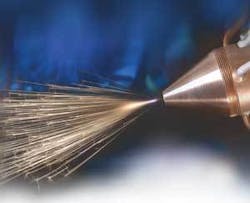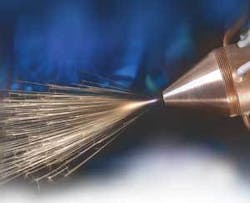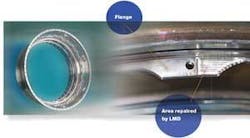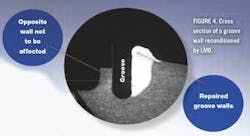Aero engine repair
Laser metal deposition as a repair technique for high-value aero engine components
Andrés Gasser, Konrad Wissenbach, Ingomar Kelbassa, and Gerhard Backes
High-value aero engine components such as non- rotating casings and vanes, as well as Class 1 rotating parts such as blades, disks, and BLISKs (blade integrated disks) made of titanium and nickel-base alloys, experience wear from statistical events, for example, foreign object damage (FOD) under operating conditions. Until now, worn-out and damaged highly integrated parts were repaired by replacement with newly manufactured parts, while single parts were repaired by conventional additive TIG welding, if applicable. This is a high-cost and time-consuming process.
Laser metal deposition (LMD) offers new prospects with regard to “not repairable” highly integrated parts and “not repairable by conventional processes” parts such as shape-distortion-sensitive casings. Further development and improvement of LMD combined with ongoing system-engineering advances such as processing heads and powder nozzles with integrated shielding gas supply have enabled the Fraunhofer Institute for Laser Technology (ILT; Aachen, Germany) in cooperation with Rolls-Royce Deutschland and other aero engine OEMs to carry out repairs on what were formerly non-repairable parts.
From process development to certification
As an OEM-certified repair shop for aero engine components, working in close collaboration with Rolls-Royce, the Fraunhofer ILT has succeeded in repairing even complex highly integrated components with a LMD process that does not require a processing gas chamber. This was achieved by qualifying certain processes developed at ILT and by designing special LMD nozzles to incorporate an optimized feeder system for powder and protective gas.
On the basis of the required metallurgical, mechanical, and geometrical specifications, all necessary steps for qualifying the new repair process are carried out in cooperation with the customer. The process qualification covers three steps. In the first step, the basic process development is carried out by investigation to verify that LMD can produce defect-free layers and volumes in the material being processed by determining the static and dynamic mechanical properties of the LMD material (by the customer) and by determining suitable process layouts and parameters on the basis of mock-up geometries.
The second step is validation of the process using genuine components by a transfer of the process layout and parameters determined before, including post heat treatment, making adjustments where necessary, by a finish-machining of the component subsequent to LMD (by the customer), and testing of the finished component in an engine test (by the customer). The third step consists of performed certification of the process after successfully passing all of these steps.
Because the processed components are primarily made of nickel or titanium base alloys, it is vital to avoid chemical reactions with atmospheric elements such as oxygen, nitrogen, carbon, and hydrogen. The use of special coating nozzles makes the repair process much more flexible (see Figure 1). In contrast to processes requiring gas chambers, there are no longer any size restrictions on the components that can be repaired. Furthermore, the technique eliminates the cost and effort of filling and emptying the processing chamber with inert gas. This offers new opportunities for OEM suppliers and providers of maintenance and repair services for aero engines.
Characteristic features
By proper adaptation of the process layout and process parameters, the LMD process results in repaired layers and volumes free of any defects such as microcracks and bonding defects, and porosity is minimized. Newly developed modular compact powder nozzles (off-axis/coaxial) guarantee contamination-free LMD for different part geometries by generation of a proper local shielding gas atmosphere. The mechanical properties of the LMD materials after appropriate heat treatment fulfill the specifications of the forged or cast raw material.
LMD minimizes component distortion in comparison with conventional deposition welding techniques. LMD produces nearly net-shape results. The typical oversize is in the range of 100-300 µm. A closed-center process chain including CAD/CAM/NC coupling is available for process implementation on genuine components. Process monitoring and control by pyrometry and camera-based systems for quality assurance aspects are currently under investigation.
Geometric features on the surface of a BR715 HPT case of nickel-base Nimonic PE16, with a nickel base Inconel 625 powder additive for bosses, brackets, and flanges, are repaired locally with just one layer deposited (see Figure 2). Because of the minimal heat input from the LMD process, distortion of the component is nearly completely avoided. The contamination- (oxidation) free LMD result is guaranteed by local gas shielding using the newly developed powder nozzles.
Damping wire grooves of a BR715 HPC Front drum made from titanium base alloys Ti-6Al-4V and Ti-6246 are repaired by a local reconditioning of the groove wall (see Figure 3). The main challenges in this application, affects on the opposite wall (heat input, remelting, etc.), are avoided completely and the processing accessibility is restricted due to the groove geometry (see Figure 4).
Installed machines
Fraunhofer ILT has helped install complete LMD machines at customers’ sites for mold and die making, gear manufacturing, and aeronautics. One example of a machine in aeronautics is the LMD machine at KLM, Netherlands. The company uses this machine for repairs of aero engine components such as disk labyrinth seals made from 17-4PH (see Figure 5).
In 2008, Rolls-Royce Deutschland will install its first LMD machine at the Oberursel, Germany site. This will help implement and establish this technology in the aeronautics field of application.
The standards set by the Fraunhofer ILT and its industrial partners in the repair of aero engine components over the last few years also benefit the FANTASIA project, a joint European project in which 11 companies from the fields of aerospace and laser technology and eight R&D centers are taking part. Launched in June 2006, the € 6.5 million project is coordinated by the Fraunhofer ILT and receives funding from the European Commission. It has ambitious objectives: a decrease of at least 40 percent in repair costs and a 40 percent reduction in the repair turnaround time for parts. Some components that previously had to be discarded due to the lack of suitable repair techniques are now repaired with the help of LMD. Six-figure savings are anticipated. It is realistic to expect a reduction of up to 50 percent in raw material and up to 25 percent in postprocessing.
The authors are all associated with Fraunhofer ILT, Aachen, Germany; www.ilt.fraunhofer.de. Contact Axel Bauer, [email protected] for more information.
Recommended reading
I. Kelbassa et al, “Repair and (Re)Conditioning of Compressor and Turbine Blades by CO2 and Nd:YAG Laser Radiation,” Proc. 7th Liège Conference on Materials for advanced Power Engineering, Liège, Belgium (2002).
I. Kelbassa et al, “Laser Radiation as a Tool for Manufacturing and Repair of Aerospace and Power Plant Components,” Proc. National Convention on Corrosion, East Asia Pacific Regional Conference, Goa, India (2002).
S. Keutgen, G. Backes, I. Kelbassa, E. W. Kreutz: “Basics on Laser Cladding of Ti-6246 for the Repair of Damaged Compressor Blades for Jet Engines,” Proc. 10th World Conference on Titanium, Hamburg, Germany (2003).
I. Kelbassa et al., “Cladding, Drilling and Shaping of Aerospace and Power Plant Components by Laser Radiation,” Proc. 10th International Symposium on Transport Phenomena and Dynamics of Rotating Machinery, Honolulu, HI, USA (2004).
I. Kelbassa, A. Gasser, and K. Wissenbach, “Laser Cladding as a Repair Technique for BLISKs out of Titanium and Nickel Base Alloys used in Aero Engines,” Proc. 1st Pacific International Conference on Applications of Lasers and Optics, Melbourne, Australia (2004).
I. Kelbassa, E. W. Kreutz, P. Albus, and L. Zhu: “Mechanical Properties of the Laser Cladded Alloys Ti-6Al-4V and Inconel 718,” Proc. 24th International Congress on Applications of Lasers and Electro-Optics, Miami, FL, USA (2005).





